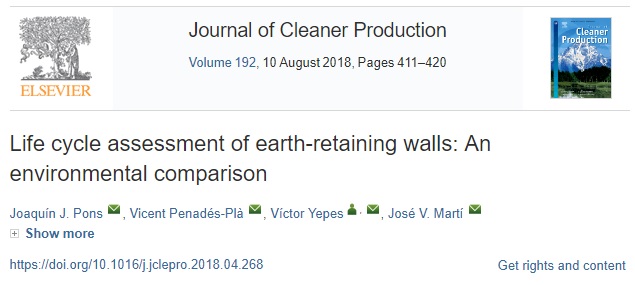 Acaban de publicarnos un artículo en la revista Journal of Cleaner Production (primer decil del JCR), de la editorial ELSEVIER, en la que analizamos una de las construcciones más habituales en la ingeniería civil, como son las estructuras de contención de tierras.
Acaban de publicarnos un artículo en la revista Journal of Cleaner Production (primer decil del JCR), de la editorial ELSEVIER, en la que analizamos una de las construcciones más habituales en la ingeniería civil, como son las estructuras de contención de tierras.
Se ha realizado para ello un análisis de ciclo de vida completo de cuatro tipos de muros: muros de hormigón armado, de hormigón en masa, de gaviones y de escollera. Además se ha realizado un estudio paramétrico para averiguar hasta qué altura de tierras es mejor una u otra tipología. Las conclusiones obtenidas no son evidentes a priori. Podéis verlas en el resumen que os paso a continuación.
Referencia:
PONS, J.J.; PENADÉS-PLÀ, V.; YEPES, V.; MARTÍ, J.V. (2018). Life cycle assessment of earth-retaining walls: An environmental comparison. Journal of Cleaner Production, 192:411-420. https://doi.org/10.1016/j.jclepro.2018.04.268
Abstract:
Earth-retaining walls are one of the most common structures in civil engineering, a discipline of the construction sector known to produce one of the highest environmental impacts. Therefore, developing cleaner design and construction practices could contribute to a more sustainable future for our planet. To make a step towards this goal, this study comprises the life cycle assessment (LCA) of the four most common earth-retaining walls built between 1 to 6 m of height: cantilever walls, gravity walls, masonry walls and gabion walls to obtain the best solutions for the environment. To assess the environmental impacts caused throughout their whole life-cycle including the production, construction, use and end of life phases, we used the OpenLCA software, the ecoinvent 3.3 database and the ReCiPe (H) method. The associated uncertainties have been considered and the results are provided in both midpoint and endpoint approaches. Our findings show that gabion and masonry walls produce the lowest global impact. On the one hand, gabion walls cause less damage to human health but on the other hand, masonry walls cause less damage to the ecosystems. Furthermore, gravity walls produce similar impacts to gabion and masonry walls between 1 and 3 m of height as well as fewer impacts than cantilever walls for a height of 4 m. In conclusion, gabion and masonry walls are preferable to concrete walls for heights between 1 and 6 m and cantilever walls should be used over gravity walls for greater heights than 4.5 m.
Keywords:
Life cycle assessment; Sustainability; Earth-retaining wall; ReCiPe
Highlights:
- Four earth-retaining walls are compared to obtain the best environmental solution.
- The OpenLCA software, the Ecoinvent 3.3 database and the ReCiPe (H) method are used.
- Gabion walls cause less damage to human health than masonry walls.
- Masonry walls cause less damage to the ecosystems than gabion walls.
- Mass concrete walls are cleaner than reinforced ones until 4.5 m of height.
